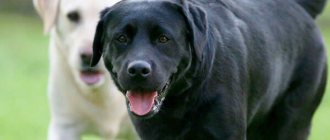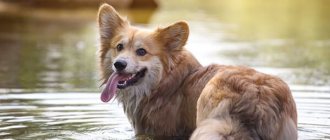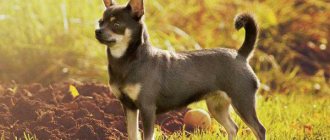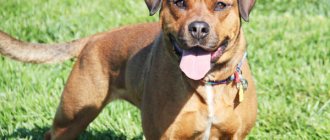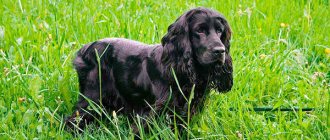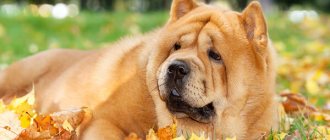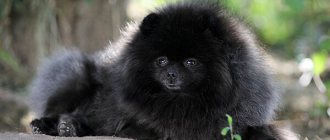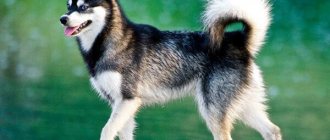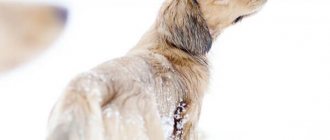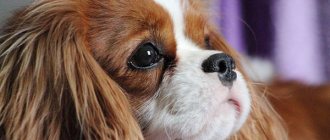The White German Shepherd is considered a rather rare breed, which was practically unknown in Europe for several decades, but is very famous in America.
Previously, such a dog was used as a shepherd, so it is still sometimes called a “herding dog” for its light color and friendly character.
In general, the albino shepherd is completely similar in appearance to its German ancestor, with only minor differences.
What details of the animal’s character are fundamentally different from the breed standard?
Origin story
During the Enlightenment of the 18th century, the German states were covered by a wave of crimes, so the question arose of creating a special service dog to help the police.
One cynological community, Philax, has set itself the goal of developing a new breed from local herding shepherd dogs from different regions of Germany (Thuringia, Bavaria, Württemberg and Saxony).
Constantly subject to criticism about what the next breed should become in the final version, the community itself did not last long.
However, it still managed to leave important developments on white shepherds:
- drew attention to the value of many qualities inherent in herding dogs;
- developed a certain view on the required type of police service dog.
Smart pets with a snow-white color quickly won the hearts of private dog breeders. Rumors about the new breed quickly spread beyond the country, and puppies began to be sold to the UK, and from there to Canada and America.
NOTE!
The descendants of the German Shepherd carry the white gene in a latent state, so each subsequent mating in 90% of cases out of 100 will necessarily produce one or more puppies of the required shade in the litter.
Left without strict control from professional dog handlers, amateur breeders made every effort to breed shepherd dogs that are in greatest demand - light-haired ones.
Today, the white color, which almost destroyed the breed in Germany as a glitch in genetics, has become one of the reasons for its popularity. Fans of non-standard species get white shepherds primarily because of their unusual appearance and character inherent in a real working dog.
Zone colors
Depending on the sources, the suit is also called:
- wolf;
- agouti;
- gray-haired;
- sulfur, etc.
Description of zone colors:
- The main color of the coat is gray.
- The undercoat and base of the guard hairs are lighter in color. The tips of the “awn” are dark.
- The coloring becomes more intense in the area of the back, muzzle, and tail. Down the body it gradually weakens and brightens. The lightest ones are the limbs of the animal.
As for color variations: from smoky, light yellow, light gray to dark brown. If the agouti is dark, you will also notice black marks on the animal's metatarsus and toes.
East European Shepherds of the “wolf” color are born with zonal colors. With age, the color does not change significantly, but owners notice that after the first moult the main background of the coat noticeably darkens.
For East European Shepherds this color is dominant. If we assume that representatives of the zonal color breed disappear, the genetic base of black and black animals will not be enough to restore it.
Zonar cubs are born if at least one of the parents has a “wolf” color. But when mating two Agouti shepherd dogs, both black and black puppies can be born. Dog geneticists have found that zonal coats have a direct effect on ensuring that the coat pigment does not weaken over time.
Photos of East European Shepherds of the zonal color:
Marriage or breed?
The dogs, known since 1882, gained recognition among dog breeders only at the beginning of the 21st century.
In the Fédération Cynologique Internationale (FCI), the white German breed was admitted for registration only in 2002, under standard number 347, in Section I of the “Shepherd Dog”, as a herding and service dog. Although this albino has nothing to do with the real Swiss Shepherd - the Sennenhund (Schweizer Sennenhund) and all its types.
Initially, the white gene was recognized as a defect, and all representatives of this breed were mercilessly culled, which led to their almost complete disappearance. But this applied exclusively to kennel clubs that adhered to German standards.
But in the USA, by that time the dog had already established itself as an independent breed and received a new name - “American-Canadian White Shepherd”. From abroad they were reintroduced to Europe, where they received a chance for renewed popularity. And although the breed is officially recognized by the International Cynological Federation, due to the fact that the United States is not a member of it, the name of the breed was changed in accordance with the norms of the federation.
Expert opinion
Kozhevin Semyon Kirillovich
Expert dog handler.
As experts note, the white shepherd is much softer and more gentle than the classic “Germans”.
But they still have the same hereditary diseases as their direct relatives:
- deafness from birth;
- dysplasia;
- heart defects;
- mental instability (aggression, hyperactivity, phlegmatic or fearful).
If the well-known standard is vigilant and tough, then the albino is more likely a pet that does not need these traits.
In addition to their spectacular color, their anatomy is striking - the white twins did not inherit the fashion for sloping croup, triangular formats and the ensuing problems with anatomy. They have retained an excellent body structure and have a calmer and more balanced temperament.
In addition, these dogs were not affected by problems with the hind limbs and back.
Black color
In our world, there are only 5% of Germans with this exact color out of the total number of dogs. While continuing to gain more and more fame, Black Shepherds are still considered "elite" due to their rarity. Therefore, puppies of such Germans cost more than their counterparts.
Black Shepherds sometimes have brown hair on their toes and hocks. There may be a slightly gray undercoat around the shoulders and neck.
If the origin of a black dog does not consist of dark breeds of other shades, then mating with it to improve the pigment is not recommended.
When purchasing a breeding puppy of this particular tone, you should never buy it with a white “tie” on its chest. Such spots are considered a defect.
Character traits
The breed in question is very dynamic, temperamental, but still distinguished by its balanced behavior.
Despite their good-natured disposition, such dogs, in case of a threat to their owners, show the qualities of a true protector.
Such shepherds have the character traits of a service dog:
- force;
- tirelessness;
- lightning-fast reaction;
- intelligence.
Therefore, they are often used as watchmen, rescuers, guides or bodyguards. In addition, they are very temperamental, cheerful and love sports, swimming, ball games and long travels.
Affectionate White Shepherds get along well with all family members, including other pets, even cats.
They behave extremely carefully with children, accepting their pranks with condescension. When communicating with “kids” in any of their manifestations (be it a person or an animal), this shepherd dog exhibits herding instincts and begins to diligently look after them.
Dogs of this breed simply prefer not to make contact with strangers, but remain distinctly distant.
At the same time, the pets of this breed are in great need of their owners’ attention and affection.
Raising and training Swiss Shepherds is not difficult - they perfectly understand and remember commands, and easily acquire new skills. But brutal methods of education are unacceptable here. There is simply no need for this - such dogs are obedient from birth.
IMPORTANT!
Poor treatment of animals, lack of communication and poor training can cause aggression towards others.
Training
White Shepherds are easy to train. They tend to become very attached to their owner and are very sensitive to aggression. Never show your aggression to a white shepherd. After all, this can cause your pet to develop depression. They need to be trained persistently, but without raising their voice. It's better to calmly talk to your dog if he is doing something wrong, and next time you will be surprised at the changes in your snow-white companion's behavior.
Accepted standard (photo)
In its appearance, the powerful and muscular white shepherd is much similar to the ordinary German breed. They are almost identical in height, but the “Swiss” is built a little denser.
Among other characteristic features of albinos, it is worth highlighting:
- body (elongated, slightly inclined to the base of the tail, the back is strong and straight, the chest is powerful and wide, the shape is oval and reaches deep to the elbows, the front part is more expressive, the stomach is tucked, and the withers are clearly defined);
- neck (muscular and partially elongated, there is no dewlap, but the line of the neck gently passes from the high-set head to the withers in a noble bend);
- head (proportional to the body, has straight line outlines, when viewed from above and from behind it has the shape of a blade, and the transition from the forehead to the muzzle is smooth, although the place of their connection is clearly distinguishable, the muzzle is elongated, tapering towards the nose, the black nose is medium in size);
- jaw (powerful, teeth positioned strictly perpendicular, scissor bite, lips characterized by a rich black color);
- ears (set straight and high, slightly directed forward, V-shaped with slightly rounded tips);
- eyes (small, slightly slanted, almond-shaped, brown or dark brown in color, with a black rim).
As a fairly large breed of dog, the height of male White Shepherds should reach 65-66 cm with a maximum weight of 40 kg, while that of females should be about 53-56 cm with a maximum weight of 35 kg.
The diagrams and photos below show what a standard representative of this breed should look like.
Black and tan color
These Germans are compared to the Doberman Pinscher, as they are essentially a black dog with brown spots, sharing the same gene.
Quite rare in the breed, the tone has small markings of a red tint in certain parts of the body. Such as cheekbones, eyebrows, chest, legs and under the tail. There is a genetic tendency to gradually discolor the black “mantle.” This means that, despite the dark appearance, with each birth the puppies will have less and less color.
There are several types of this color:
- weakened;
- saturated;
- darkened.
These dogs are used specifically for working breeding.
Life expectancy and health
Typically, white American-Canadian Shepherds do not have serious health problems, so they are often long-lived, reaching 15 years of age or more - like typical representatives of the German breed.
Only in isolated cases can hereditary joint dysplasia occur, which sometimes occurs in large breed dogs. To avoid this, until the age of 6-7 months (or better yet, up to 1 year), hold off on heavy physical activity when raising your pet and do not get carried away with drugs that stimulate the animal’s growth.
Basic safety measures—compliance with the schedule of required vaccinations—will also help prevent your pet from getting dangerous viral infections.
The health of your pet directly depends on the quality of food and care. The breed has no specific diseases or pronounced hereditary weaknesses.
Unlike their German relatives, albinos are less likely to suffer from plague and enteritis, and are not prone to allergies, eye diseases and joint diseases.
NOTE!
In old age, special attention should be paid to the condition of the eyes (elderly dogs are especially sensitive to the effects of dust, wind, sea water), so it is necessary to wipe the eyes with a solution of chamomile or weak tea, and clean the ears with a special stick.
Read about what diseases shepherds can have here.
Non-standard colors
From time to time, puppies are born with deviations in color (blue, brown or white). These dogs are sterilized and given away as pets. Color should not be a reason for euthanasia.
White color
The partial albinism gene can be carried by a German Shepherd with a strong black coat and mask, but with sandy/gray tan markings. Sometimes such a dog produces fully or partially white puppies.
Considering that a small white spot can be found even on a dark wolf, such markings of a shepherd dog are often ignored (unless this sign extends). Pink claws on your fingers will also tell you about the manifestation of the white spotting gene.
Brindle color
This type of color is classified as extinct, although at one time (at the founding of the breed) it was almost the main one. The brindle gene is expressed on the tan area, causing black and tan shepherds to have black stripes/markings throughout the tan area (like brindle boxers). The color looks quite attractive, but so far not a single shepherd dog with a brindle zonal color has been presented to the field of view of dog handlers.
Blue and brown colors
Both options are not strictly prohibited, but they contradict the standard due to the incorrect coloring of the nose: in blue and liver shepherd dogs the nose is not black, but brown or gray. However, US breeders are increasingly trying to produce blue and brown "Germans" that have an impressive appearance (with 4 shades in both colors) with silver-yellow eyes.
With the blue gene, the black pigmentation changes to steel gray with the traditional tan color (sometimes with silver notes). With the liver color gene, the black pigment gives way to brown.
Rules of care
Like all large breed dogs, the Swiss White needs plenty of space to live and play. Therefore, it is better to have such a pet for owners of the private sector and a wide yard, because even in a two-room apartment the pet will be cramped and uncomfortable.
To stay fit and healthy, the shepherd needs regular walks and training - running with weights or running with small obstacles.
From the very beginning, the animal must be accustomed to order and following basic commands - this will greatly simplify further training. The puppy adapts to new conditions much more easily, gets used to people and animals living in the apartment. When purchasing an adult dog, it will be much more difficult to accustom him to new routines.
But a properly raised white shepherd will become the best companion for children, an affectionate friend for the owner and at the same time a formidable guard for any strangers.
In order for a puppy to grow into a healthy and beautiful dog, every day he must consume at least 150-200g of meat, two eggs, 150-200g of cottage cheese, as well as bone meal, herbs, and cereals as a supplement.
IMPORTANT!
Among dry food, you need to choose premium class options. They are more expensive, but saving on your pet’s health is also risky. On cheap food, animals more often suffer from cholelithiasis and kidney stones, and sometimes even cancer, after which their life expectancy is significantly reduced.
Treatment
Self-medication is not always effective, and sometimes even destructive for the animal. When a puppy develops diarrhea, it is necessary to contact a veterinary clinic to rule out parvovirus enteritis.
Safe at home:
- Balance the diet - remove bones, raw fish or meat, and indigestible carbohydrates.
- If there is a suspicion of poisoning, ask enterosgel.
- For bloating, pain and nausea, take Polysorb or phosphalugel.
Price range
The average cost of a puppy ranges from 15-45 thousand rubles.
The final cost is formed under the influence of various factors - the region of purchase, the color and age of the dog, the presence of a pedigree and titled parents.
In the capital, puppies of this breed are sold for a higher price than in the provinces, and purebreds are much more expensive than mixed breeds.
Common features
The message refers to the pet's tail. The tail of a purebred dog looks straight, saber-shaped and droops downwards. But judging by a single sign is wrong. The tail can change as it grows, you need to look at the totality of signs.
Purebred puppies often look awkward at first. By about two months, they begin to grow very quickly and gain weight, literally before our eyes. The body stretches out and gains the proportions necessary for a shepherd dog. Mutts don't grow that fast.
How to choose your future pet?
One of the most common mistakes when choosing a puppy is the pursuit of cheapness. Therefore, it is safer to purchase a puppy at a higher price, but through a club or from well-established experienced breeders.
It is also worthwhile to carefully examine the animal yourself, observe its behavior, and at the same time collect complete information about the heredity, training and character of the sires.
Check whether testing was carried out by dog handlers, whether inbreeding (related matings) or cases of culling among albinos due to unstable psyche were observed in the pedigree. Such facts make it possible to identify in advance pathologies and diseases that may appear when the dog grows up (at 2-5 years).
NOTE!
Qualified and conscientious breeders always openly provide such information, because they are also interested in finding a good home for their four-legged pupils.
Zonal gray color
The most original color in the line of German Shepherd colors. It is from this that the rest of the colors originate.
In common parlance it is also called “wolfish” and this is understandable. After all, a distinctive feature of the coat color is the ring sections: there is an alternation of yellow and black hair. The base is lighter.
Predominant over other colors, the zone-gray color does not have a hidden gene. Puppies with this shade can only be born if one of the parents has a gray color.
Thanks to the primitive power inherent in the genotype, it maintains a high biopotential of pigmentation.
This endangered German Shepherd has the highest energy levels.
Rejected colors of German shepherds
Deviations from the norm are quite rare, taking into account the modern development of breeding. However, it is impossible to fully predict the genetic intricacies. Therefore, a puppy with a defective tone can be born to a healthy couple that meets all standards.
Such individuals do not participate in exhibitions and are not allowed to breed.
However, as a loyal friend, they are no worse than their titled and certified brothers.
White "Germans"
This phenomenon is possible if the puppy has a recessive white gene from both parents. These dogs are not albinos in the usual sense of the word.
They have black noses, claws, paw pads, and characteristic dark eyes.
Yellow German Shepherds
Otherwise they are called redheads. Despite their beautiful appearance, they are also considered defective, since they do not correspond to the established saddle cloth type.
Golden "Germans"
This color is a subtype of the defective yellow color. Appears in the presence of bright pigment.
The coat of such dogs seems very light, but shimmers gold in the sun.
Spotted color
Speaks for itself. The coat of such German Shepherds can have many spots, and in a variety of tones and sizes.
It is characteristic that these marks are often located in a chaotic order. Typically, the spotted color appears in mixed-breed “Germans” and outbred dogs.
Roan Shepherds
This color is not an independent variety. It occurs as a result of age-related changes when the dog's coat becomes pale and less saturated. When gray hair occupies most of the area, we can safely speak of a roan color.
Those who want to get a German Shepherd of an unusual color should always remember two points:
- puppies of a rare color that corresponds to the standard (black and zonular) will be much more expensive than the usual black-and-white ones;
- dogs of defective colors are not allowed to participate in exhibitions and for breeding.
Therefore, you should choose a pet based on your own goals.
One thing can be said with confidence: “Germans” of defective colors are no less loyal friends than those that correspond to the standard.
Owner reviews
Valery, 32 years old:
“Life with a White Shepherd is a life of constant adventure. A sharp mind and love for various pastimes make this dog an indispensable companion for both me and my two boys. And she definitely has a sense of humor! - Exactly!
Vasily, 53 years old:
“I have a descendant from the first “Swiss” in our country, brought here from the Czech Republic back in 2003. The pedigree says “FBCollet of Kim*s Dream”, and I am extremely proud of this record, although I understand that this is not my pedigree . It turns out that I am no stranger to vanity. By the way, the descendant himself is very cunning and resourceful, he calculates my every step and acts according to his calculations. A dog of extraordinary intelligence!”
Anna, 24 years old:
“Wool requires special care, not in terms of combing, etc., but because from an excessive amount of any substance in the diet (carrots, beets, seaweed, etc.), the wool turns yellow.”
Ginger
Red color is a deviation from the breed standard. Strictly speaking, this dog cannot be completely red in color, but areas of fur of reddish shades are allowed. For example, if the dog is black and tan, he will definitely have red hairs on his coat. Therefore, if you become the owner of a pure red “German”, the road to exhibitions will be closed to you. However, a red dog of this breed will become your wonderful friend, no worse than an animal with the “correct” coat color.
In fact, even in other types of shepherd dogs, such colors are extremely rare, so it is not surprising that red “Germans” practically do not exist.

